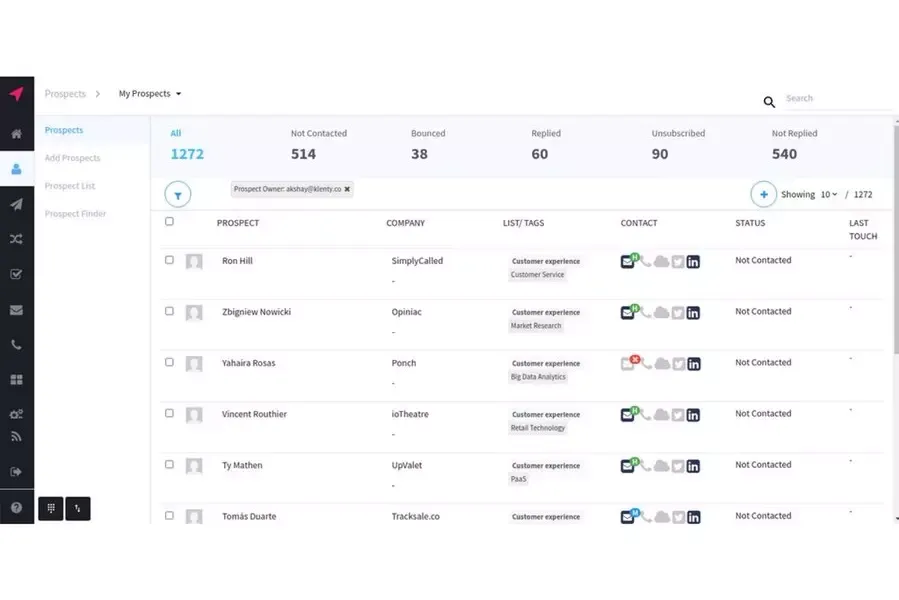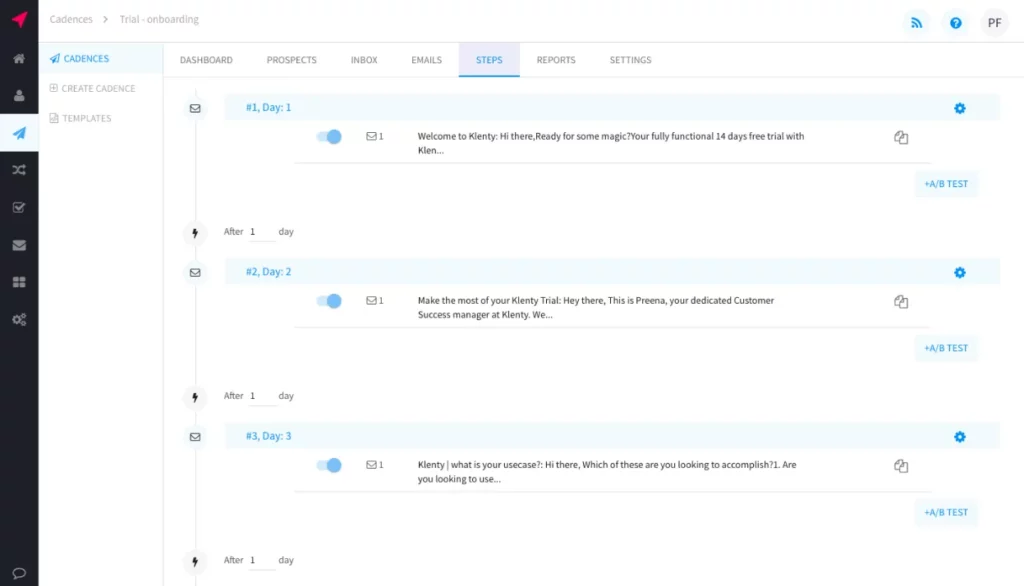There is a lot you can say about outreach:
It’s time-consuming.
It’s fun.
It’s very, very boring.
It’s necessary.
It’s mundane.
It’s outdated.
Everyone’s doing it.
Not many are doing it right.
What you can’t deny about outreach though is that you do need to do it. There is no marketing campaign without it.
Take content marketing: how can you promote your latest piece without reaching out to interested parties and letting them know about it?
Or link building, that ancient art of the world of SEO: emails are your daily bread when building links.
Sales is no different: your leads are not magically going to come knocking on your door having never heard of your product before.
Another thing you need to know about outreach is that the success of your campaign comes down to the way you organize it. It’s easy to send out a dozen emails every day. But when you are dealing with hundreds or even thousands of them, you will definitely want to have an email outreach tool in your arsenal. Preferably one that will help ease the stress, not add to it.
Without further ado, let's look at the five of the reasons why you should be getting yourself an email outreach tool.
5 Reasons Why You Must Use an Email Outreach Tool
1. It Streamlines Cooperation
Doing outreach on a daily basis means you have to stay on top of a very hectic inbox at times. I’m talking about seventeen newsletters, twenty-one replies asking you for more information, and sixteen emails asking you to be taken off the outreach list.
And while Gmail and other email clients can offer you labels and folders, which can help to a certain extent, once you reach a certain amount of correspondence, it will simply turn into a mess. And this will cripple your productivity in no time.
Add to that the fact that you might not be the only one doing said outreach, and you are in quite the pickle.
An Email Outreach tool like Klenty makes it much easier for two or more people to work on the same campaign, seamlessly and without having to come up with the own secret language of signs and subfolders.
Everyone will know just where the other person has left off, what prospects have been contacted, when and with that email template. And trust me, this will save you many a headache that arises when you contact the same prospect twice in one week.
Even if you don’t have an entire team of people typing away at emails, there will likely come a time when more than one person is tasked with outreach. A tool provides a unified and straightforward way of keeping track of emails, campaigns, results, prospects, email templates and everything else you might need for the campaign to run smoothly. Not something you can streamline in Gmail.
The tool will house all of your precious data: and it can be deployed by anyone at any time. All you need to teach newcomers to the table is how to use the strategies and operations you already have in place.

2. It Makes Reporting Easier
Email outreach is a numbers game, to be perfectly honest. The more emails you send out, the more you will learn. And the more you will sell, needless to say.
An email outreach tool makes it easy to stay on top of response rates, opens and clicks – data you can also use to improve your tactics.
Imagine having to manually count the number of emails you’ve sent out last month. Every month. That’s a day’s work in itself, figuring out the statistics alone.
Your friendly office outreach tool will share this information with you within a few clicks, and you will suddenly find yourself wielding a very powerful weapon.
What that means is that at the end of the month, you can just tap into your tool’s statistics and send out a report to your clients or superiors, and show them exactly what has been done - which prospects have been found, how many have been outreached, what they have replied, etc.
This data will make it much easier to get others to opt for the best-working tactics – it’s hard to get people to adopt a new idea, without concrete proof. Proof that you now luckily have at your disposal.
Next time someone asks you why a certain goal has not yet been met, you will have data to show for yourself. No more meetings trying to convince others to see things from your point of view.
Outreach tools make it very easy to justify the time spent on a certain campaign: even when the results you were hoping to achieve are nowhere near the finish line yet. Your hard work will no longer be brushed aside with a demand for more results – it will be hard to refute when it is sitting right there in the report.
3. It Provides a Better Overview
Let’s talk about user experience for a minute.
While your email client might have just gotten a brand new layout, it still can’t beat the way an email outreach tool is organized. You don’t have to dig for a label or try and find out how your colleague would mark a certain outreach stage in an inbox. You can simply look at it in the tool.
In other words – you will know exactly when you are running low on prospects. Or when you have reached your goal of sending out a certain amount of emails. Or closing a certain number of deals. Or even when you are running low on bandwidth.
Another plus you have to take into account is the fact that you will be able to track the work of your employees or colleagues as well. In turn, this will make you quickly realize the strengths and weaknesses of your team, and you can accordingly find a better way to tweak your processes.
After all, blogger outreach comes down to the organization – and having a tool that can help you improve it should not be turned down lightly.
Wouldn’t you prefer having to glance at a single window and keep track of all your active campaigns and their statuses, instead of having to utilize several screens and at least seven windows?

4. It Enables Development and Improvement
Let’s imagine for a second that you don’t know that much about outreach. You are simply new to this game and are not quite sure what you are doing.
You hire an assistant who has done some prospecting and link building campaigns in the past, and they bring their own unique ideas to your table.
Using an outreach tool enables you to test drive all the ideas the two of you come up with, without having to guess at the results. You know that subject line A is working, while subject line B, which has shown so much promise when you came up with it, is actually a flop. And so on.
The list of possibilities is endless when you can set up smaller campaigns to test run your ideas, even outside your official client or in-house campaigns.
Who knows what you will be able to come up with if you can easily and time-efficiently test something, without having to copy/paste an email template over and over again, or having to keep tabs on the number of certain subject lines sent.
Your outreach tool will provide a steep learning curve you can fast overcome, using nothing more or less than the numbers that are now attached to the work you do: reply and open rates, click rates, conversion rates.
5. It Is Scalable
Probably the best thing about outreach tools is that everything in them can be scaled.
You need more prospects: you can find them.
You need more email templates: you can add them.
You need to connect more email addresses: you can do that too.
You need more people working on your campaigns: that is easy too.
With an email client, all you can do is cause more confusion in an already overcrowded inbox. Outreach tools will let you segment things nicely, so you never have to dig for something you need to find fast.
In fact, the more you use the tool, the smarter both you and it will become. You will learn how to tweak all its features, and you won’t have to sacrifice progress for the sake of productivity. Quite the contrary – you will have already improved your processes, your templates, and everything else so that you can now use all the experience you have gathered to take things to the next level.
What Do You Need To Look For in a Good Email Outreach Tool
We talked about the benefits a lot, but we shouldn’t disregard the importance of choosing the right tool.
Here are a few things you should pay closer attention to if you are searching for an email outreach tool:
- Why You Should Move to an AI SDR Instead of Just AI Email Outreach Tool? When choosing an email outreach tool, the key isn't just automation—it's smart automation. With AI advancements, look for a tool that integrates AI into every step of the process. An AI SDR that runs itself is your best option.
AI SDRs like SDRx automate your outreach campaigns, delivering a list of engaged prospects who have shown interest in your solution. It builds prospect lists, qualifies leads, researches them thoroughly, and crafts personalized emails for each contact—no more generic templates. It even optimizes follow-ups based on prospect engagement.
In short, your entire outbound process runs on autopilot with outbound AI SDR, freeing you to focus on warm leads with the highest potential to convert into deals. - It should not be a marketing automation tool that sends emails from a third-party email server. Your email outreach tool should rather be able to connect to your corporate email account (Gsuite/Office 365/domain, etc.) and be able to send emails from that server. By sending emails via marketing automation tools, you are more likely to end up in the spam folder and your email open rates will suffer.
- Solid reply detection. Your email outreach tool should be able to detect replies to your mailbox and also classify the mails as bounces/auto-replies and actual replies. Once this classification is done, the tool should allow you to automatically follow up with the prospects who have not replied and stop the outreach for the ones who did. The worst thing that you want is to send a follow-up email to a prospect who has already replied.
- Integration with CRM's. If you already use a sales CRM, you understand the need to maintain a system of record for all sales conversations. The outreach tool should be able to integrate with the CRM and sync all data automatically so that your sales reps can have an understanding of the history of conversations with this prospect - How long did it take to respond, how many touches were required, what was the pitch that got the prospect excited, and any other information that could help them close the sale.
Conclusion
Even if it takes some time getting used to the interface and the structure of your new outreach tool, the time you invest in familiarizing yourself with it is worth it as you will reap rich dividends very soon.
You will suddenly have all the data at your fingertips, and if you use it wisely, you can skyrocket your very next email campaign.
Don’t shy away from testing out different ideas: after all, the tool is just what its name implies: a very clever piece of software that is there to help you, the mastermind of the operation, get to the finish line faster, and with a lot more energy conserved.

Dario Supan is a content strategist and editor at Point Visible content marketing agency. When he isn’t neck-deep in outreach projects and editorial calendars, you will most likely find him designing a custom graphic for his next exciting post.

